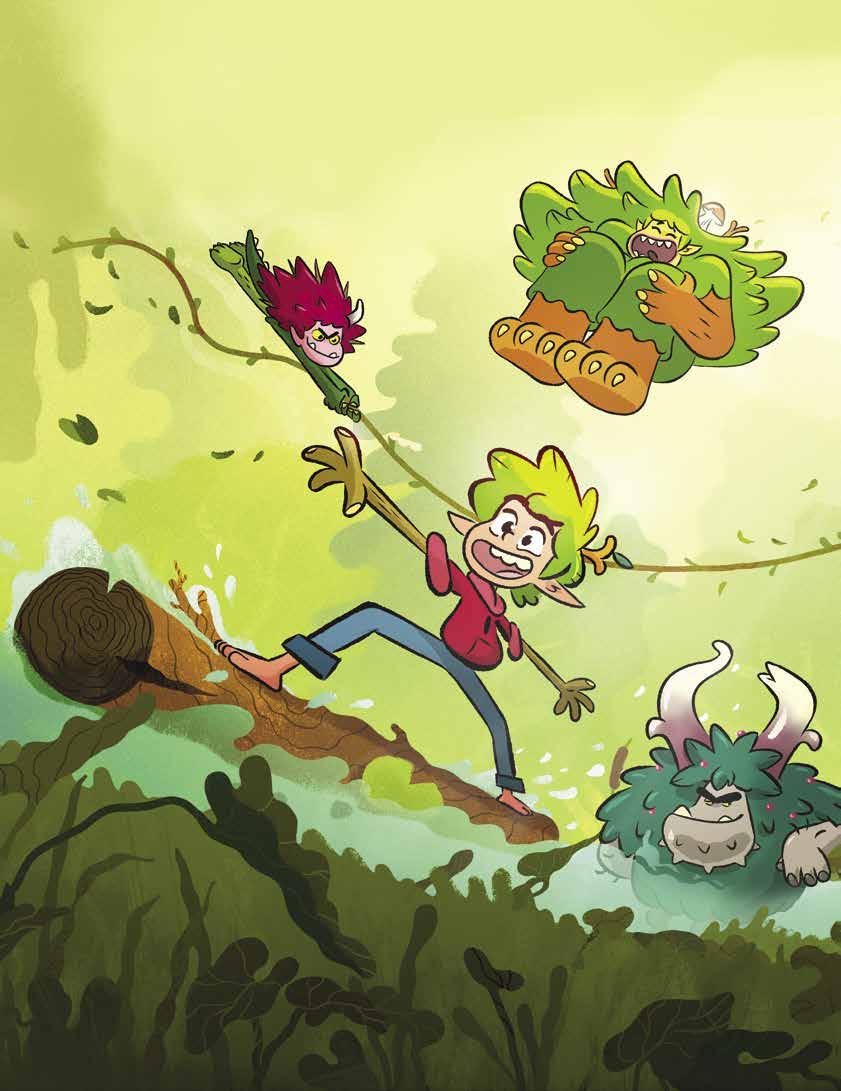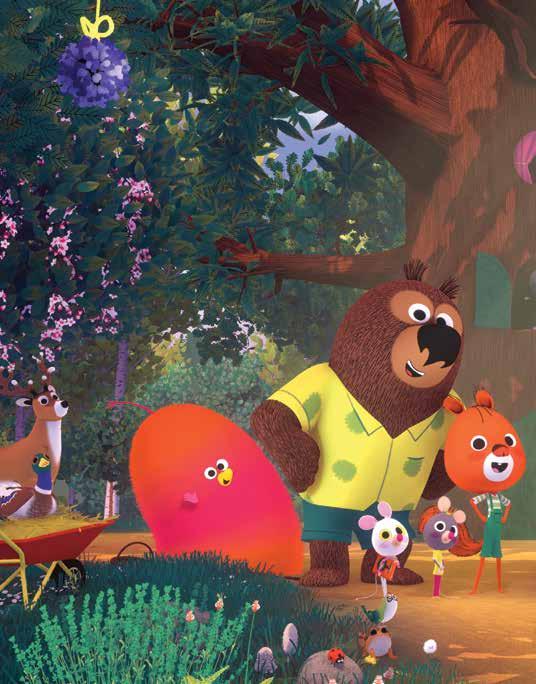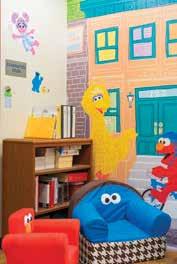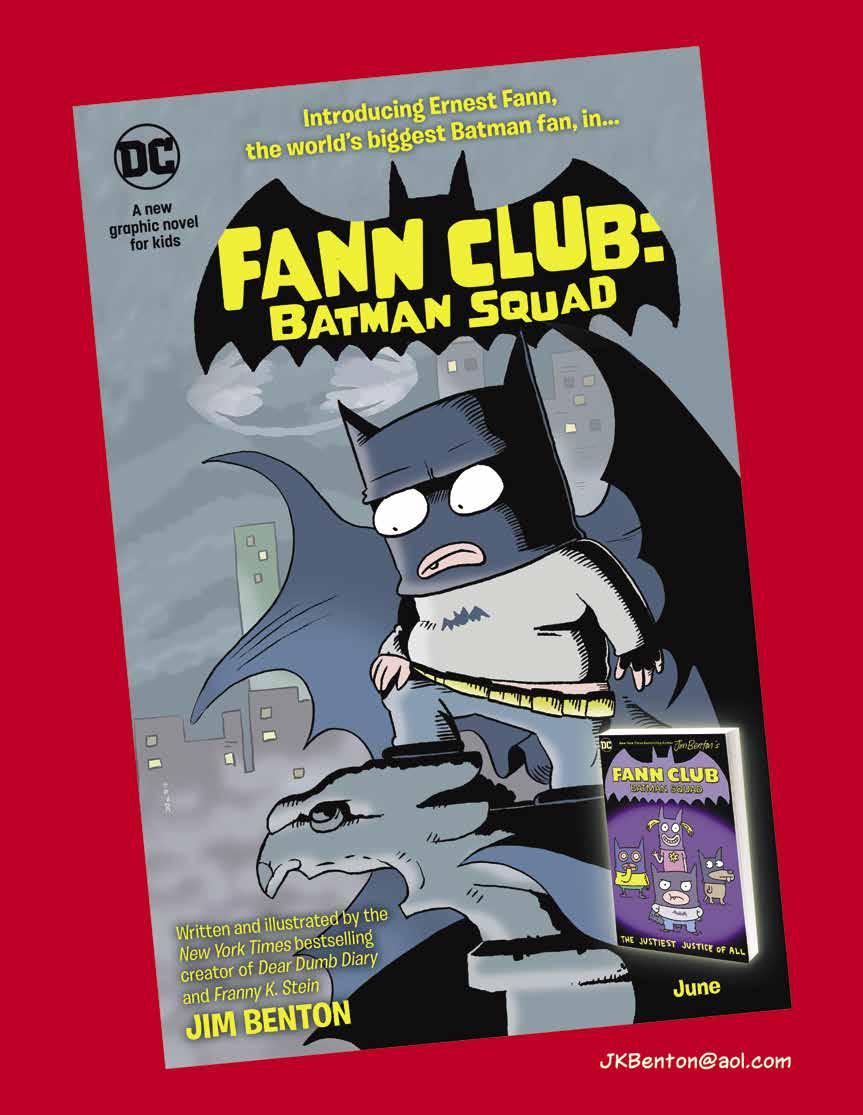





 engaging the global children’s entertainment industry
engaging the global children’s entertainment industry
8 16 18 22 27
moves
The List—What’s on our radar this month, from tax incentives and screen quotas to toy trends.
Decoding and nurturing a growing global interest in eco-themed and climate-focused kids content.


The wooden toy category is primed for growth as parents shift towards more sustainable alternatives.
Sesame Workshop outlines a content journey for hard-to-reach community audiences.


The first in our new series helping you navigate key issues around artificial intelligence in the kids biz.
As FAST channels multiply, experts say the trend will continue. Grafi2000 is gearing up to expand its King Shakir IP into a global brand.pring took a long time to arrive in Toronto, where Kidscreen’s offices are located. And we had the kind of winter—grim, late to arrive, and even later to leave—that got me thinking: Is it just me, or is winter totally messed up these days?
The sad truth is, it is messed up. As this issue went to press in March, scientists delivered a “final warning” to the world to fast-track efforts to combat climate change or risk irreversible harm to the planet. It was meant as a wakeup call, and it may have resulted in some complex conversations at home for some of you. Because if it’s on adults’ minds, it’s on kids’ minds, too—they have very finely tuned emotional antennas.
TV, films and games are not exactly at the forefront of the environmental movement, but we do have the privilege of being on the front lines of kids entertainment. So what we do matters. With that in mind, for Earth Month, we wanted to pause and take a look at some of the ways that sustainability and environmental issues are seeping into our industry. We wondered: Do kids actually want their entertainment to tackle stuff like climate change and recycling? Or are they looking for content that lets them escape?
The Family Room’s George Carey might argue—as he did so persuasively at Kidscreen Summit—that we should just be letting kids laugh and have fun. His research indicates that kids are tired of edutainment after three long years of intermittent at-home
schooling, so we need to lighten things up for them a bit and just let them be kids.
This doesn’t mean that producers and broadcasters need to avoid big issues, but it does require some creative thinking. For example, Sadhana Bharanidharan recently spoke with PBS KIDS chief Sara DeWitt, who says the greenlight for Al Roker’s Weather Hunters series came from an insight that teaching young kids about the basics of weather offers a conduit to understanding climate change later on.
And on the consumer products side of the biz, Kidscreen columnist Christopher Byrne predicts that market forces are tilting the toy industry towards sustainable tactics, with parents seeking feel-good/do-good playthings for their kids, and schools incorporating climate change into (some) curriculums, thereby driving older-kid interest in sustainable companies and practices.
I think you can never go wrong by staying on the sunny side of the street, though. Writer Andrea Hernandez and I were totally charmed by the idea of Oscar the Grouch becoming the Chief Trash Officer for United Airlines, a delightful marketing approach the company is using to get people to pay attention to the arcane topic of alternative aviation fuels. Instead of boring explainer videos, Oscar is uniquely positioned to engage United’s wide and diverse customer base in an entertaining way, giving the company’s sustainability messages a much better chance of getting through.
On that front, it was a coincidence that the Oscar news came in tandem with this issue’s Kid Insight column, in which the Sesame Street in Communities (SSIC) team presents a primer on getting specialty content out to niche or hard-to-reach communities. It has never been harder to connect with target audiences, and SSIC’s practical, accessible suggestions are well worth considering for those with content that has a mission.
I hope you enjoy this issue, and that it sparks some thinking about how your company can make a difference, however small.
SVP & PUBLISHER
Jocelyn Christie jchristie@brunico.com
EDITORIAL
EDITOR & CONTENT DIRECTOR
Katie Bailey kbailey@brunico.com
ASSOCIATE EDITOR
Janet Lees jlees@brunico.com
FEATURES & SPECIAL PROJECTS EDITOR
Jeremy Dickson jdickson@brunico.com
NEWS EDITOR
Ryan Tuchow rtuchow@brunico.com
STAFF WRITERS Sadhana Bharanidharan sbharanidharan@brunico.com
Andrea Hernandez ahernandez@brunico.com Cole Watson cwatson@brunico.com
CONTRIBUTORS
Evan Baily, Justine Bannister, Christopher Byrne, David Cohen, Stefanie Cousins, Sofia Polo, Gary Rusak
BUSINESS DEVELOPMENT & ADVERTISING SALES (416) 408-2300 or 1-800-KID-4512
ASSOCIATE PUBLISHER Maggie Wilkins mwilkins@brunico.com

ACCOUNT MANAGER Lia Minquini lminquini@brunico.com
CREATIVE ART DIRECTOR
Taylee Buttigieg tbuttigieg@brunico.com
AUDIENCE SERVICES
DATA INTEGRITY & CUSTOMER SUPPORT SUPERVISOR Christine McNalley cmcnalley@brunico.com
CORPORATE PRESIDENT & CEO Russell Goldstein rgoldstein@brunico.com
EVP & EDITORIAL DIRECTOR Mary Maddever mmaddever@brunico.com
SVP & REALSCREEN PUBLISHER Claire Macdonald cmacdonald@brunico.com
SUBSCRIPTIONS To order, visit www.kidscreen.com/subscribe. To make a change to an existing subscription, please contact us by email (support.kidscreen.com). Fax: 416.408.0249 Tel: 416.408.2448.
Kidscreen is published seven times per year by Brunico Communications Ltd. Subscription rates in the US are US$89 for one year and US$159 for two years, and single copies are US$7.95. Please allow four weeks for new subscriptions and address changes.
REPUBLISHING & SUBMISSIONS
Nothing in Kidscreen may be reproduced in whole or in part without the written permission of the Publisher. All letters sent to Kidscreen or its editorial team are assumed to be intended for publication. Kidscreen invites editorial comment, but accepts no responsibility for its loss, damage or destruction, howsoever arising, while in its office or in transit. All material to be returned must be accompanied by a stamped, self-addressed envelope.
POSTMASTER NOTIFICATION US Postmaster: Send address changes to Kidscreen, PO Box 1103, Niagara Falls, NY, 14304. Canadian
Postmaster: Send undeliverables and address changes to Kidscreen 8799 Highway 89, Alliston, ON, L9R 1V1. Canada Post Publication Agreement number 40050265 (printed in Canada) ISSN number 1205-7746 - ©Brunico Communications Ltd. (2023) Kidscreen® is a registered trademark of Brunico Communications Ltd.
—Katie Bailey Watch
issue

Politicians always love the razzle-dazzle that comes with backing the entertainment industry, from the photo opps, to the location cameos, to the press releases about positive local impact. But the UK government’s recent move to support beleaguered kids TV producers with an upgraded incentive scheme seems like a genuine effort to bolster the sector. Industry bodies like PACT have released statements of support, and producers are voicing cautious optimism. The new Audio-Visual Expenditure Credit (AVEC) offers kids productions a rebate of up to 39% on 80% of a project’s qualifying cost—an augmented and streamlined version of AVEC’s previous two-tiered scheme offering 20% to 25%. As of press time, producers were still unsure about how much of a difference it will make when all the i’s are dotted and t’s crossed (full details have yet to be released). But it’s a shot in the arm and a vote of confidence for an industry battling challenges on a number of fronts, including digital migration, declining commissions and funding crunches. The good news is that incentives like this are a boon outside of the UK, too—especially for smaller markets like Canada that rely on co-productions to boost budgets.
10 things on our radar this month
Following the lead of countries like France and Canada, Australia will introduce new local-content quotas for major streaming platforms starting in July 2024. The mandate is part of a broader government plan to reform and support the country’s producers working in all genres, including kids.


Tweens may soon be jamming up the toy aisles as they hunt for the latest collectibles that are trending on TikTok, according to The Toy Association. Meanwhile, parents want toys that teach their preschoolers new skills like mindfulness or sleep routines. And it doesn’t hurt if they’re made in a sustainable way.


Unionization drives aimed at major studios have firmly taken hold, particularly with production workers. Previously nonunion production staff at Nickelodeon Studios and Walt Disney Animation Studios have recently partnered with The Animation Guild (TAG) to negotiate their first collective agreements, and it’s a safe bet that similar conversations are happening elsewhere.

The partnership between Africa’s MultiChoice, NBCUniversal in the US and Brit broadcaster Sky will signifantly scale up MultiChoice’s Showmax SVOD, and the company is also building a library of original kids content. Meanwhile, a recent Digital TV Research report predicts that Africa will have 15.6 million paid SVOD subscribers by 2028—and this audience is young and content-hungry.

The Beeb transitions CBBC to online-only, and ITV joins the club as it prepares to move its linear kidsnet content to streaming in July. Digital is clearly winning the battle against linear in the UK…or is it? Sky Kids’ linear channel, just a few months old, makes a case for old-fashioned curated viewing maintaining a place in our streaming-skewed world.



YouTube is sunsetting its original content program, prompting the departure of execs such as global kids head Craig Hunter, and putting some shows already in production and development in jeopardy. It was disappointing to see another big-name kids content buyer exit the scene—especially since YouTube is such a big part of early viewing experiences for young kids.

Some things just don’t age well, and stories are not immune. Striving for better representation and inclusivity, Puffin is revising and reimagining the works of Roald Dahl, while Disney’s new The Little Mermaid featuring a Black lead—is tracking to be a major hit.
After shuttering its animation unit, Reese Witherspoon’s Hello Sunshine pivoted to live-action kids and family programming and hired former Disney exec Lauren Kisilevsky (Descendants, pictured). We’re interested to see where the prodco’s seemingly keen interest in the kids biz will go next.
Kids digital powerhouse pocket.watch found a deep-pocketed partner in influencer platform Jellysmack, and together the duo has launched a fund to help creators ride out algorithm-fueled financial ups and downs, giving YouTube-first talent more TV-style creative stability.
Turkish
BY: JEREMY DICKSONhere’s a new lion king staking out his territory in the global kids and family media landscape—but this one’s Turkish, wears a blue hoodie, and answers to the name Shakir.
The teenage feline is the star of King Shakir (pictured), a 2D-animated kids and family comedy from Istanbul-based Grafi2000 (Ali The Cavity And Necati The Microbe) that has become a massive ratings hit for Cartoon Network Turkey. It now airs on CN in 18 countries across the Middle East and North Africa (MENA) region.

Since rolling out domestically in 2016, King Shakir has also expanded into a wide-ranging MENA region franchise that includes theatrical feature films (2018’s Game Time and 2019’s Land of Pirates); a pair of 45-minute TV movies (Virus Hunters and Splash); a consumer products program with 300 licensed products in 50 categories; a publishing range that has sold more than six million books; a YouTube
channel with 110 million hours of watch time and counting; plus popular theme parks, live shows and digital games.
Now, Grafi2000 is aiming to turn King Shakir into a global brand. To kickstart its goal, the company recently struck a key streaming deal with Disney+ for distribution of the IP’s third CG-animated feature, Recycle (2022), as a Disney Original Movie. After a successful

prodco Grafi2000 is setting the stage for its popular King Shakir IP to become a global brand.
























Turkish launch in December, the film (main character pictured) is now available on Disney+ in 150 countries worldwide, including the US, Canada, France and Australia. Though Disney+ won’t share any data, King Shakir’s co-creator Varol Yaşaroğlu says the SVOD had a significant advertising budget for Recycle in Turkey, and did a great job localizing the movie for other countries.
“King Shakir is so big in Turkey, it was their choice to invest as much as they did,” says Yaşaroğlu. “Plus, they made some nice changes to the localized versions, while keeping some of our local Turkish culture intact.”
Grafi2000 is currently in negotiations with Disney+ for a hybrid animated/ live-action King Shakir movie.
Yaşaroğlu credits the brand’s success in MENA to its non-violent family-friendly appeal, timely topics, relatable characters and globally relevant storylines that touch on everything from climate action to gender equality and healthy living. King Shakir’s environmental themes have become so popular, in fact, that the animated character was named a kid ambassador for the United Nations Development Program in January 2022, joining a campaign to introduce children and their parents to the UN’s sustainable development goals.
Created by Yaşaroğlu and Berk Tokay, King Shakir is Cartoon Network’s first and

















only original Turkish animated series. Set in modern Istanbul, its 11-minute episodes center around the sometimes-intergalactic adventures of a loving family of lions and their friends.
Seven seasons have aired locally to date, and an eighth that’s in production now will bring the show’s total episode count up to more than 250.
Looking ahead, Yaşaroğlu says Grafi2000 is very open to discussions with global distributors, channels/streamers and licensing partners. “We’re currently negotiating with Netflix Turkey on more King Shakir content,” he says, adding that the first two seasons of the series and the first two theatrical films were all top performers on the streamer. “The challenge is to find good partners outside of broadcasting deals.”
One such partner is virtual world brand and NFT marketplace The Sandbox, which struck a deal with Grafi2000 in June to take King Shakir into the metaverse for the first time.

As for regional expansion, Grafi2000 will focus first on Europe, Asia and likely Latin America. “Since Turkey is right in the middle of Europe and Asia, its content has the ability to appeal to both the western and eastern worlds,” explains Yaşaroğlu “We also know that Turkish dramas are doing amazing in South America, so we believe there will be a huge audience for Turkish animation there, too.”

ritish broadcaster Sky has launched a new ad-free linear channel for kids, with a programming strategy that’s designed to inspire, energize and educate them as they move through their typical daily routines.
Aimed at the under-seven set, Sky Kids launched in February. It was a move that surprised many in the industry, but the broadcaster’s audience insight data indicated it would be welcome in the market, says Lucy Murphy, Sky’s director of kids content. “Research shows there’s a 50/50 split between on-demand services and linear TV when it comes to kids’ viewing habits.”

Linear TV is still engaging for kids because it exposes them to new shows and content genres; it’s simpler, so it doesn’t overwhelm kids with too many options; and families like linear’s carefully vetted viewing experience. “Parents want fun and educational content in a single format that keeps their kids from stumbling onto things they shouldn’t be watching,” Murphy notes.
The linear format also revives the art of strategic programming for different parts of the day. In the morning, the channel offers classic brand favorites such as Madagascar and LEGO, later folding in more active shows that introduce music, dance and gymnastics, arts & crafts content to keep kids busy after school, and bedtime programming to help them wind down in the evening.
Current series include Trolls: TrollsTopia, Where’s Wally, 123 Number Squad! and Clifford the Big Red Dog, as well as Sky originals MC Grammar: Wonder Raps, Pip and Posy, The Brilliant World of Tom Gates and Morph

Going forward, Sky Kids plans to build a library of British content, both new and acquired. “This will complement some of Sky’s services that carry US shows from channel brands such as Nickelodeon, Nick Jr. and Cartoon Network,” says Murphy.
On the new channel’s post-launch shopping list are animated and live-action shows (minimum 20 x seven minutes) for kids under age seven based on familiar IPs or featuring recognizable people/characters. Sky is also on the hunt for animated specials, series designed to inspire kids to be active without a sports hook—think dance and fitness content—and music-centric programming.
By 2024, Sky will also be in the market for animated comedies and educational content (both live-action and animated). The channel is not currently seeking any animated preschool shows with songs, or concepts in the superhero, anime or action-adventure genres.
Original series that debuted on Sky Kids this year include Ama’s Story (four and up), about a Black girl’s search for a book that reflects her life experiences, and BooSnoo! (two and up), targeted at kids who have learning disabilities. On the future releases front are Ready, Eddie, Go! (three and up), centering around a character with autism, and My Friend Misty (five to seven), which aims to foster emotional resilience.


Kidscreen checks in with new, established and evolving kids content buyers to find out what they’re looking for right now. For more of this type of intel, check out our Global Pitch Guide at kidscreen.com.Lucy Murphy, director of kids content for Sky Kids Clay stop-motion series Morph is part of Sky Kids’ current lineup The upcoming Ready, Eddie, Go! stars a character with autism
THE BIG GIG: VP and creative director of development at BBC Studios Kids & Family
PREVIOUSLY: Manager of animation series (EMEA) at Netflix
ANIMATED AMBITIONS: Growing up with a love for animation (particularly The Simpsons) and live-action shows like long-running BBC kids drama Grange Hill, Barnieh knew very early on that he wanted to work in the TV business. “As a teenager, all my friends stopped watching animation and other kids and family-type shows, while I just carried on.”
Starting out as an intern at Nickelodeon UK in 2003, he rose up the ranks to become the kidsnet’s content manager by 2012.
GLOBAL STORYTELLER: Barnieh’s CV is one of robust international experience. He oversaw acquisitions for WarnerMedia APAC from 2013 to 2019, based out of Hong Kong, after which he moved to Singapore to join Netflix as manager of international kids & family originals in the same region. “From living in three different countries and working for American companies, I’ve gained a skillset of being able to understand which story might appeal to which audience,” he says.
SHUFFLING GENRES: Since November 2022, Barnieh has been overseeing development at BBC Studios Kids & Family under the leadership of managing director Cecilia Persson. Barnieh says his main goal is to authentically reflect UK culture through storytelling. “Quite often, a lot of stories about the UK are told by other people, and they don’t really reflect 2023 Britain.”
The slate Barnieh is currently developing includes both animation and live-action dramas targeting kids of all ages, in addition to broader four-quadrant audiences.
He says he would also like to tackle unscripted content—which would be a new genre for him. With the appeal of unscripted short-form videos on social media, Barnieh sees an opportunity to make longer-form content along these lines, but elevated with “the amazing production values of BBC Studios.”—Sadhana
 Bharanidharan
Bharanidharan
 BY: JIM BENTON
BY: JIM BENTON
Why one of America’s biggest airlines turned to an iconic kids character to battle air pollution.
BY: KATIE BAILEY & ANDREA HERNANDEZike peanut butter and banana sandwiches, United Airlines and Oscar the Grouch might seem like an unlikely combo at first. One is America’s fourth-largest air carrier with a primarily adult customer base, and the other is a beloved children’s TV character who lives in a garbage can.
But Oscar’s love of trash is exactly what United is hoping can help communicate the complex topic of sustainable aviation fuels (SAF) to consumers of all ages. United is actively backing SAF—which is made from cooking oil and agricultural waste—in a bid to someday adopt sustainable fuels in its operations. (The company recently invested in NEXT Renewable Fuels, which is looking to build a biofuel refinery in Oregon, with production starting in 2026.)
Typical explainer videos showing how banana peels transform into engine fuel aren’t likely to be very engaging to most people, but watching Oscar take on a new role
as United’s “Chief Trash Officer’’ has a totally different value proposition.
And that’s at the heart of a major new media campaign from United and its ad agency, 72andSunny. In more than 30 pieces of original content across video, digital, social and outdoor media, Oscar will be onboarded into his new position. He’ll meet airline employees in real-life United workplace situations, and they’ll explain how SAF turns trash into treasure (among other topics) in everyday, all-ages language.
When United and 72andSunny approached Sesame Workshop with the idea, it was an undeniably “perfect fit,” says Jennifer Ahearn, VP of strategic partnerships. But Sesame always has to weigh corporate requests to use its iconic IPs against the nonprofit company’s core mission—to better the lives of kids through quality content. So putting together a partnership of this size and nature can be a complex undertaking.
“We are very selective about these types of partnerships. We evaluate the entirety of what a partnership can look like and [ensure] that our partners support our mission,” explains Ahearn. “We worked very closely hand-in-hand with [United]. We review every piece of content to ensure that it’s up to our brand standards, and that Oscar and his love of trash are portrayed accurately.”
Sesame’s characters have multigenerational appeal, she notes. “So many adults, grandparents and parents grew up on Sesame Street… and that’s usually why brands like United want to work with us. So when they wanted to feature Oscar in this campaign because of his love for trash, we said, ‘That sounds really interesting. But of course, it’s really important for you to support our mission.’”
In this case, United made a donation to the Welcome Sesame initiative, which provides content and support to children and families in crisis zones. The airline also incorporated Sesame Workshop into its Miles on a Mission program, which allows travelers to donate their United loyalty points to various causes. (The program funneled 13 million miles to 40 nonprofit partners last year.)
Can Oscar the Grouch turn the tide on airline-fueled carbon emissions, spurring consumer demand for more sustainable options? That’s a tall order for a short-canned monster. But if he can charm people into paying attention—and inspire them to think bigger about trash, consumption and sustainability—that’s a win for the whole world.

 BY: SADHANA BHARANIDHARAN
BY: SADHANA BHARANIDHARAN
co-themed content is something more and more producers seem keen to provide, and it’s a good fit for public broadcasting’s socially focused mandates. But do kids themselves want it? Evidence from recent industry research says yes.
Demand for climate-focused programming is becoming increasingly consistent across the globe, rather than region-specific, says Pete Robinson, chief strategy officer at UK research firm KidsKnowBest.
The subject is showing up in a growing number of course outlines for all grade levels in schools, and young activists like Greta Thunberg and crazy-popular YouTuber MrBeast—who successfully executed a fan-led campaign to plant 20 million trees by 2022—are popular with slightly older kids, stoking curiosity and interest among younger ones. Plus, it’s in the news all the time.
KidsKnowBest conducted polls last year with kids ages six to nine in North America, Europe and Australia. On average, nearly a third of all respondents said they want to see environmental themes in their media. “As children become more aware of environmental issues and want to engage with characters they relate to, it feels like this is a space that [more] children’s content-makers should take notice of,” says Robinson.
In the UK, broadcaster Sky Kids commissioned a survey of 2,000 children ages seven to 14 last fall for its weekly news show FYI The findings revealed that half (50%) of kids are frightened by climate change, with 43% believing it to be the biggest issue the world currently faces.
Data like this has weighed into Sky Kids’ strategy to commission more optimistic
climate-focused edutainment. The channel launched a variety of content related to climate change last fall, including the informative live-action film COP27: Six Ways to Save Our Planet and season two of CG-animated series Obki for five- to nine-year-olds.
Obki creator Amanda Evans says the show’s alien main character delivers big laughs, but also reels audiences in with kid-friendly insights into complex topics like the environmental impact of microfibers. And while tackling these issues in such a tight episode format (30 x two minutes) was a writing challenge, Evans points to the renewal from Sky Kids as evidence that the short-and-sweet messaging worked.
Elsewhere in Britain, fledgling prodco Peace in a Pod Productions is turning its
Vivi the Supervegan book property (written by the prodco’s CCO Tina Newman) into YouTube shorts initially, with an eye to a dedicated app, merchandise, and a longform series down the road.
Veganism may be a complicated topic for kids to digest, so Peace in a Pod CEO Lindsay Watson plans to focus on more accessible and kid-friendly themes like animal welfare and compassion for the Earth. “We won’t be mentioning the V-word,” she says. “Instead, we’ll generally reflect on some of the choices humans make and explore what choices allow for a more sustainable future.”
Animation is particularly effective for this kind of content because it communicates so much through action, Evans adds. As an example, in one episode of Obki, he cranks
up the heat in his ship before his Alexa-like companion, Orb, shows him that he could just wear warmer clothes instead.
Public broadcasters have always been fertile ground for programming with a purpose, and the PBS KIDS team is looking for ways to bring kids into the climate conversation without overwhelming them.

Sara DeWitt, the channel’s SVP and GM, gives this advice to producers: “You can’t get ahead of yourself too fast [by jumping into topics like] fossil fuel effects and greenhouse gases. You need to think about this through a kid lens, and what’s observable by them. You have to back way up and start with foundational concepts that kids need [in order] to process the wider intricacies of climate change.”
One good starting point that PBS has identified is the weather. In January, the pubcaster greenlit Weather Hunters (40 x 22 minutes) from New York’s Al Roker Entertainment. This 2D-animated series targets five to eights and stars a young girl who investigates weather patterns.
“We wanted a show that was very specific about weather,” DeWitt says. Weather Hunters was a perfect fit, thanks to its science premise (introducing kids to concepts like meteorology) and the participation of real-life weatherman Al Roker, who “has been dreaming of doing a series like this” for some time, according to DeWitt.
Since kids have a built-in “poser” radar, many companies are also hyper-aware that they need to practice what they preach.
Green initiatives are starting to permeate the broader TV industry, influencing tech software, marketing plans and, in some cases, dedicated senior roles (Netflix, Sony). On the indie side of things in the kids space, French prodco TeamTO recently moved into a new eco-friendly Paris studio—which helped it achieve a 63% reduction in its overall carbon footprint—and has invested in creating new, more energy-efficient software tools for energy-intensive CG animation.
And the company is interested in sharing what it has learned from these investments. President and co-founder Guillaume Hellouin says TeamTO will make some of its new tools open-source in order to allow other companies to use them.
Elsewhere in Paris, MIAM ! animation is actively incorporating sustainability into its company ethos. Cleaner production pipelines are a top priority on shows like Edmond and Lucy (52 x 12 minutes), which uses more energy-efficient real-time image rendering and features environmentally conscious storytelling.
The series is the first industrial-format animated series produced with Unity software, which speeds up production and reduces computer-generated carbon footprints. “With real-time, our episodes are rendered in only a few hours using a single machine, instead of several computers over a number of weeks,” notes founder Hanna Mouchez.
Outside the studio, MIAM ! plans to organize a series of nature workshops in which French kids will watch an episode of Edmond and Lucy and then play together outdoors, adds Mouchez. (Obki Productions’ Evans also envisions initiatives like themed beach cleanups and a merch range of products featured in the series, such as bamboo toothbrushes and eco-friendly adhesive bandages.)
MIAM ! is already working on its next ecothemed series for Canal+—a CG-animated comedy called The Tinies, in which a group of toys uses everyday household items for entertainment (to introduce preschoolers to the concept of upcycling).
Mouchez argues that the most effective content avoids stoking eco-anxiety by blending a fun and hopeful tone with useful information, rather than ringing alarm bells. “Kids don’t want to be alerted—they already are [alert].”
As parents shift away from buying plastic toys for their toddlers and towards more sustainable alternatives, the classic and reliable wooden toy category is primed for growth.
BY: COLE WATSONoy soldiers, craft dolls, miniature kitchens and alphabet blocks. Wooden toys have existed in the market for nearly 3,000 years, having made their debut in Germany sometime in the 1700s.
Despite the rapid growth of electronic toys, video games and licensed products in the modern retail landscape, these seemingly simple classics continue to captivate preschoolers and parents alike with their nostalgic charm and proven durability. But is there an opportunity brewing for more toycos to take up the hammer and chisel and elevate this category to new heights?
New York’s Creative Kids certainly thinks so. Since opening its doors in 1998, the toyco has focused on manufacturing arts & crafts products for kids of all ages, ranging from easels and crayon sets, to modeling clay and sticker kits. And in 2019, the company made its first move into the wooden toy market.
“We got into wooden toys based on a customer request, and very quickly, we started learning the ropes of what the category looks like,” says CMO Daniel DeLapa. “We realized early on that there aren’t a lot of name brands in the wood toy market other than one or two key players, which
was our opportunity to come in and disrupt the market.”
Since the release of its first wooden toy products three years ago, Creative Kids’ range in the category has expanded to feature CoComelon- and Blippi-branded chunky puzzles, Baby Shark stamp sets, spinning reading blocks and a roleplay workstation.
As the company began to build up market momentum, it needed a partner to help take its business in wooden toys to the next level, says DeLapa. Enter MGA Entertainment. Creative Kids inked a deal in August 2022 to bring the LA-based company’s Little Tikes preschool toy brand into the category, and launched a first line of wooden vehicles and alphabet blocks at retailers across North America in September.
“MGA had considered getting into wooden toys in the past, but it had never focused on the category at this scale,” says DeLapa. “Together, we felt there were huge disparities between the prices that market leaders were demanding and what was in the customer’s pocket. We’re aiming to

come in close to 40% under the retail prices offered by other competitors.”
Under the partnership, Creative Kids designs and manufactures the toys, and Little Tikes manages distribution. Together, they plan to roll out more than 15 SKUs of Little Tikes wooden toys in the UK and Ireland this spring, and plans for more launches across Europe are currently being mapped out.
Meanwhile, Creative Kids is expanding its Little Tikes range with more interactive products, including giraffe-shaped music tables, gear puzzles, roleplay kitchen sets and Montessori-inspired activity boards.


“Parents are constantly looking for products that educate and entertain their kids,” says DeLapa. “All the toys that we’re producing are targeted at the preschool market and focus on key early-learning fundamentals like color sorting, bilateral coordination and shape identification.”
He adds that the recipe for success in the wooden toy market isn’t pushing new features or gimmicks into products, but keeping them as simple and as affordable as possible.
“This is a global toy market worth over US$20 billion,” DeLapa says. “Our biggest challenge in the category is determining how to deliver a high-quality product at a price that parents at every socio-economic level can afford. And the way we’re doing that is by controlling our expenses far more aggressively than our competitors.”
A 2022 report published by India’s Maximize Market Research forecasts that the global wooden toy market will grow in value from US$23 billion in 2021 to more than US$28 billion by 2027. Nearly 75% of this
business is generated in North America and Europe, but MMR predicts that the APAC region will soon start to emerge as an important market as the demand from millennial parents there for more educational and construction toys increases.
There’s also another key factor that’s helping to propel the category’s growth. “I think a good portion of what’s driving the wooden toy market today is parents focusing on sustainability,” says Thomas Kaeppeler, president of Ravensburger North America. “They’re now looking for new alternatives because most plastic toys are oil-based—so when they end up in landfills, they never break down—whereas wood is inherently a sustainable resource.”
Based in Germany, Ravensburger entered the wooden toy category in 2015 when it acquired toyco BRIO from the Swedish investor group Proventus. Founded in Sweden in 1908, BRIO is a pioneer in wooden toys, having invented several historic classics that it continues to produce, including miniature railways, pull-along Dachshunds and stacking clowns.
“Before acquiring BRIO, we had been watching the company’s progress in North America and Europe for a long period of time, but I was questioning whether wooden toys were still a play concept that intrigues kids,” explains Kaeppeler. “After visiting several independent and specialty toy stores around Europe, what blew me away was how many kids and parents would approach the BRIO display table. It was easily the most frequented fixture that day, and kids would jump right into pretend play.”
While American toycos such as Mattel and Hasbro have only recently begun to look for ways to eliminate plastics from their manufacturing processes and reduce emissions and waste, European toycos have been adopting sustainability policies and practices since as early as 2010, says Kaeppeler. For nearly 10 years, all of the wood used in BRIO’s toys have come from renewable forests grown and harvested in the Balkan region of Sweden. But cost is still a major challenge.
“We wanted to ensure that our footprint is significantly lighter on the environment than other companies,” says Kaeppeler. “But any product that is sustainably managed has the new challenge of rising manufacturing costs. The cost of both wood and plastics have jumped significantly since the pandemic.”
According to a 2021 report by Canadian consulting firm Capgemini, social and environmental issues are increasingly affecting purchase decisions. Of more than 7,000 consumers surveyed, 79% said environmental impact would sway them not to buy a product, and 52% feel an emotional connection to products and companies that are sustainable.
Another challenge for Ravensurger is continuously innovating the product line and coming up with new ways for kids to immerse themselves in pretend play.
“There’s only so much you can execute from a technical perspective with wood,” says Kaeppeler. “If you want to elevate the play pattern, you have to look at ways to integrate technology safely, source the right materials, and stay sustainable—all while combining that into a toy.”
With this design philosophy in mind, BRIO has added two new trains to its iconic BRIO Builder wooden railroad system. The first is a battery-operated steam train that kids can fill with water. As the locomotive speeds down the track, its stack produces cool water vapor that looks like steam but is safe to touch. The second newish SKU is a Smart Engine that launched in 2019. When this train passes through one of its Action Tunnels, it lights up, emits sound effects or changes direction.
More broadly, Kaeppeler remains optimistic about the growth prospects of the preschool toy industry. “Like most markets around the world, birth rates have been declining for years. But [thanks to the pandemic], for the first time in a long time, we’re having more babies, which is healthy for the toy industry at large. Down the road, they’ll need toys, and we’ll be here as they grow up.”
hen California-based Green Toys’ first product range hit retail shelves in 2010, the company’s mission to use 100% recycled materials made it an outlier in the sector. It was a niche strategy at a time when consumers, manufacturers and mass culture at large were just beginning to become sensitive to the ecological impact of consumer products and manufacturing.
Sixteen years later, the world has changed, and sustainably manufactured products matter to the majority of today’s consumers. Recent research clearly shows this: A 2022 survey by US-based Do Something found that 75% of Gen-Z consumers (people born since 1997, representing about 26% of the global population) desire sustainable products and value sustainability over brand.
Moreover, Gen-Z consumers are savvy, and they know authenticity. If companies are claiming to be green or sustainable, they’d better be for real…or they risk being called out. As always, the toy industry is paying attention.
It’s important to define what sustainable means in the context of consumer products. It really boils down to three concepts. First, sustainable toys don’t deplete natural resources. Second, they are made in an
ecologically responsible way. The third component—social responsibility—may not be as obvious. It’s a slightly different interpretation of the word “sustainable,” but in this context, it means maintaining levels of respect, care and well-being at all levels of a company. With consumers increasingly looking for proof that the companies they deal with are sustainable, many are now publicly posting information about their sustainability programs. In recent years, Mattel, Hasbro, Plan Toys and The Toy Association have continued to revise and expand their sustainability mandates. These are readily available and worth a read, both to see the level of commitment these industry leaders are making, and to gain insights on where they see the industry going.
Notably, the shift to place a higher value on sustainability is taking place on the B2B side as well. This year, in response to requests from international buyers, the Hong Kong Toys & Games Fair began a program that encourages manufacturers to put a leaf sign on their stands to call attention to green toys.
Historically, cost has been a deterrent to adopting sustainable practices, but even that is changing. New technologies are making sustainable materials more affordable and
accessible. One example is bioplastics made from renewable resources. According to Dublin-based Research and Markets, the use of bioplastics is set to soar—even though the material is more expensive—because it’s cost-efficient to use, requiring 65% less energy to manufacture than conventional plastic. And the market research firm predicts that continued R&D will result in further cost reductions over time. Meanwhile, my ongoing conversations with marketers and Gen-Z consumers indicate they’re willing to spend a bit more on products that reflect their values.
Mattel’s 2021 launch of the “Barbie Loves the Ocean” line (pictured)—with toys made from 90% recycled plastic—was a smart play that will likely resonate with kids who may be learning about plastic pollution in school. These positive moves are not a silver bullet, but they are steps in the right direction. And there are more steps to come, since the toy industry always reflects the culture at large.
Will toys heal the planet? Probably not. However, the awareness and practice of eco-consciousness that green and sustainable toys can instill in a generation of kids will shape their values and futures. And that’s what good play does.


 I P W O R K
I P W O R K
I P W O R K
I P W O R K
 BY: SOFIA POLO, STEFANIE COUSINS & DAVID COHEN
BY: SOFIA POLO, STEFANIE COUSINS & DAVID COHEN
hildren’s content has the power to positively impact children’s lives in ways that ripple through generations, and that’s the reason why many of us do what we do. But while we may try to deliver content that authentically reaches a diverse range of families, we have to ask: Are we achieving that goal? And if not, how can we do better?
Identify potential partners with strong connections to local communities, such as healthcare organizations, nonprofits and educational institutions. We believe that a key part of success here is giving community stakeholders co-leadership roles right from the beginning. Here are some questions to consider.
Now it’s time to get to know the community—like, REALLY get to know it. Get out there (or go online) to conduct interviews, focus groups or surveys to understand your target population’s context, needs, beliefs and attitudes as related to your topic. Connecting with the community in this way will also give you the opportunity to learn about effective ways of distributing the content. Here are some tips to get you started.
Let the results of your research guide your content development and distribution. Having the help of community partners at this point is essential. As you know, it’s challenging for any content or campaign to capture the attention of busy parents with young children, especially those from underserved communities. However, when a trusted community organization disseminates the content, those parents are more likely to see it, trust it, and absorb its messaging. Here are some suggestions.
At Sesame Street in Communities (SSIC), we’ve tried to formalize the answer to this second question. Although our efforts lean on the reach and resources of Sesame Workshop, we believe that elements of our model can be incorporated by other companies that want to more strategically develop and distribute their content (or supporting campaigns) to specific or hard-to-reach communities.
Population: Is there a group of people that you are specifically interested in creating content for? If so, reach out to social service organizations that provide outreach to that community.
Subject matter: Who might have subject matter expertise or an interest in your topic? It’s helpful to consider community partners who can contribute ideas and who will also benefit from the outcome.
Capabilities: What can the community partner realistically offer for the delivery and implementation of content? Successful partnerships begin with clearly communicated expectations about responsibilities and level of involvement.
Use step 1: Community partners likely have relationships with the people you want to reach. Engage them by asking them to help recruit research participants, host focus groups or review interview questions to ensure that they are culturally and linguistically sensitive.
Choose the right methodology: Focus groups and interviews, for example, let participants tell stories that highlight their lived experience, and they work great for research that’s meant to inform decisions about an upcoming project. There are also online platforms (such as bulletin boards) that provide a freeform space for research participants to respond to your questions in writing. You do not need to recruit hundreds of research participants—many SSIC studies recruit as few as 25 people for this type of research.
Hire a research consulting firm: Not all of this needs to fall on your shoulders, and there are often affordable options.
Organize family-friendly events at local schools or community centers where materials are distributed.
Conduct sessions to show healthcare providers and caregivers how to access and use the materials.
Work with librarians and healthcare providers to connect with community members.
Let’s take a look at how this works on the ground. In 2018, SSIC launched an oral health initiative targeting Black and immigrant families with young children in Los Angeles County. We set out to address how content could improve oral health outcomes for young children.
Why oral health? According to the US Centers for Disease Control and Prevention (CDC), tooth decay is the most common chronic disease in young children, and it affects highrisk children beginning in infancy and early childhood. Children with poor oral health miss more school days and receive lower grades than children with good oral health.
We became aware of this issue as part of a National Maternal and Child Oral Health Policy Center meeting in Washington, DC in 2006. Once we identified the opportunity for content to play a role in improving this outcome, we set about building our strategy.

Partner selection: We decided to partner with the UCLA School of Dentistry because it was determined that SSIC resources would be a valuable complement to its existing “More LA Smiles” children’s health awareness campaign.
Research: We partnered with Fluent Research, a consulting firm with expertise in children’s media and community-based research. They were selected through a competitive RFP process based on their experience in conducting research and evaluations of media-based resources and initiatives with young children and their caregivers. The research consisted of a series of interviews and focus groups with parents, early childhood educators, and dentists who serve Black, Latino, Korean, Chinese and Filipino families in Los Angeles. SSIC’s community partners played an instrumental role in carrying out this research by identifying and recruiting hard-toreach research participants.
Analysis: The research highlighted specific financial, psychological and immigration-related factors that make accessing oral healthcare a challenge for parents, and pinpointed common misconceptions and hesitations around diet, oral hygiene and dentist visits. The research also identified schools, daycares and doctors’ offices as trusted settings for accessing information about parenting and health.

Execution: SSIC and its community partners developed several strategies for distributing the content, including events at schools and clinics, the distribution of booklets and online videos to childcare and healthcare providers, and a social media campaign that involved local businesses and organizations posting bilingual graphics and videos promoting the importance of tooth-brushing (featuring Elmo and Grover, of course!). SSIC also worked with community partners to install Sesame Street-themed “Comfy-Cozy Spaces” in their facilities, where children can play with plush Sesame Street Muppet toys and parents have access to the oral health content.

Results & follow-up: After one year, a review of the campaign’s reach found that it had exceeded its goals, generating nearly 700,000 views of the oral health videos and increasing SSIC’s following on Facebook by 112%.
This is just one example of how SSIC uses its community-centered model to develop content and supporting campaigns that successfully target hard-to-reach populations. Although it has its challenges, even small steps toward blending aspects of this model into your content development and distribution process can make a difference.
At the end of the day, infusing community voices into content helps producers make more authentic programming, but it also ends up
having a much deeper impact on the people and audiences who are targeted to consume it.





















 BY: EVAN BAILY
BY: EVAN BAILY
lthough artificial intelligence (AI) has been creeping into the mainstream for a long time, it feels like the tech has suddenly arrived on our doorsteps, demanding to be invited to dinner. But the reality is that we are already using it, and we’ll be using it even more very soon. So to help you navigate this bot-infested landscape, we’re kicking off a limited series of columns about AI, focusing on the key issues our industry will need to consider as we start to make critical decisions about how this technology will affect our businesses.
“Transformers” are AIs like GPT-4 that take inputs (text or images primarily) and turn them into outputs—scripts, images, music, video, or even code. They learn how to do this by ingesting huge amounts of data. The buzzy AI platform Midjourney, for example, has been “trained” on hundreds of millions of images, which it uses to inform the creation of new “original” images in seconds. And that’s where the ethical problems start to arise.
Anything that absorbs vast amounts of human-created data also absorbs—and therefore has the potential to spread—human biases. This is a global issue that has attracted the attention of government bodies including the US Federal Trade Commission, and NGOs like UNESCO, and it’s a critical issue for the creative community. How will we prevent AI from injecting widespread biases into the most influential of all entertainment products—kids media?
The unfortunate reality is that most AIs steal—collecting “training data” without consent. Now, if an image generator like Midjourney uses stolen images to learn to recognize shapes or objects, that’s not really harmful. But when an AI generates artwork that mirrors an artist’s style with eerie accuracy, it’s a problem. For example, “Cronenberg” is a banned word on Midjourney because too many people were aping the director’s distinctive visual style. How will we protect creatives—who spend years mastering their craft—from this type of theft?
Don’t pick up your pitchfork just yet—AI isn’t all bad. When the camera came along, many believed it was the death knell of painting. But it liberated painters from the centuries-old project of realistic representation and spurred them to invent new modes of creation such as Impressionism and Cubism. As AI infiltrates TV and film production, what new vistas will open up for human creativity?
One certainty is that AI will usher in incredible efficiencies for content creators and prodcos. Tools like Facebook’s Make-A-Video can already generate full animation, so photorealistic video isn’t far behind. How will we work to ensure that these efficiencies deliver not just higher profit margins, but also new opportunities and gains for creatives?
These are just a handful of the questions, concerns and issues the industry will need to examine as AI is adopted into business strategies and project pipelines. Please drop me an email (ai@conbail.com) if you have an idea to explore in a future column.

As artificial intelligence’s presence grows in the entertainment business, Kidscreen launches a new series examining the pressing issues facing the industry.
The FAST channel landscape is expanding rapidly, but can revenue generated from kids content keep pace?
BY: GARY RUSAK
he emergence of FAST channels and platforms around the world, and particularly in North America, was one of the major stories in content distribution last year. Experts say the trend is likely to maintain momentum in 2023 for several reasons, including household subscription fatigue, connected TV sales, a bursting global inventory of content for sale, and a very low barrier of entry to consumers and operators alike.
The appeal of a more passive viewing experience that’s reminiscent of the old days of linear TV—as opposed to the “tyranny of choice” that defines AVOD and streaming platforms—is substantial, according to Katrina Kowalski, VP of content for Paramount+ and Pluto TV Canada.
She says the successful and high-profile launch of FAST channel platform Pluto TV in Canada at the end of 2022 is illustrative of the market’s growth worldwide. “All signs point to consumers really embracing the product, owing to the economic times we find ourselves in.”
Pluto TV’s Canadian FAST platform launched on December 1 with 117 channels, including 10 kidsnets featuring blue-chip IPs such as Dora the Explorer and Teenage Mutant Ninja Turtles. One only need look at some topline revenue numbers industry-wide to see why content and technology companies are jumping on board to introduce new FAST channel options into the market.

Global ad revenue for FAST channels in 2021 was US$2.4 billion, according to Tim Westcott, senior principal analyst for digital content channels at UK-based research firm Omdia. That number nearly doubled to US$4.4 billion in 2022, with the US alone accounting for US$3.9 billion. America is clearly the most robust FAST channel market so far, but the rest of the world is expected to start catching up in the coming quarters as broadband access and connected TV sales outside of the US continue to expand.
Two different business models have emerged in the early days of FAST. “Overall, the most common model seems to be revenue-sharing,” says Westcott. “So if you operate a channel, the platform is going to sell the advertising for you.”
The second most popular model, he says, is inventory-sharing, where both the channel and platform operators sell ad space and split the profits. Revenue-sharing is currently emerging as the predominant approach, with some obvious benefits for both channel owners and platforms. Roku and Pluto TV have both adopted this model, leveraging the efficiencies of the platforms’ sales force to deliver ad revenue—a skillset many IP owners lack.
Revenue-sharing also gives IP owners a look under the hood of the platforms’ analytics, which can reveal valuable information about how their content is being consumed. This stands in stark contrast to the traditional reluctance of streaming platforms to share deep analytics.
“We have an external dashboard for all of our partners,” says Ashley Hovey, senior director for AVOD at The Roku Channel. “Our partners can log in and see 16 different data-points. If they are scheduling their own channel, they need that insight.”
The success of fusing the right content strategy with viable ad sales will be the main factor in determining how big a role FAST eventually plays in the kids content marketplace. Right now, the challenge is that advertising dollars are harder to secure in the kids space than in other content categories. Even with the reduced ad load for kids (across most platforms, this comes in at around six to eight minutes an hour—less than for other types of content), there’s still a hill to climb in terms of selling this inventory. “There is a bit of smoke and
mirrors around ad sales in kids,” says Paul Coster, founder and CEO of UK-based VOD365, which owns FAST channel Ketchup TV. “A lot of platforms are onboarding kids content, but when it comes to monetization, it is a much more challenging scenario.”
Advertising around kids programming has both content and privacy restrictions, limiting the use of automated (also called programmatic) ad sales, which are driving FAST’s revenue growth in other genres.



“Even if there are five to eight minutes of ads per hour, [platforms] are probably only filling half of that in terms of real ads being served on the channel,” estimates Lara Ilie, VP of revenue share and transactional at Canada’s WildBrain. “That is the reality of where the kids monetization is today.”
For this reason, some content owners prefer to handle their own ad sales, as Ketchup TV does. But that limits a channel’s exposure. “Some platforms won’t entertain the idea of you doing the monetization of your own inventory,” says Costner. “That leaves your destiny in their hands, and if they aren’t filling the inventory, that is really a concerning point.”
Because of this ad crunch, Paul Robinson, managing director of Kartoon Channel! at Genius Brands International, calls FAST channels for kids a “break-even proposition” at the moment. But he remains optimistic that a brighter future is ahead. “No one is paying a fortune for FAST rights in kids right now,” he says, “but if the advertising really takes off, that will be revised.”
With kids ad revenue still finding its footing, the key in the meantime might be to leverage FAST channels to build IP awareness, which can then produce revenue across other verticals like licensing and merchandising. However, there is optimism that kids FAST channels themselves will soon be in the black.
“At first, the channels are going for the easy revenue, and that is in non-kids,” says WildBrain’s Ilie. “But in time, they will be able to fine-tune their approach, and those ad dollars will come.”
The way digital ad spend is generally structured might also be a source of optimism for platforms and channels looking to monetize their kids inventory. In some cases, digital spend is locked in up to 12 months in advance. This means that advertisers who are considering relocating their ad spend to growing kids FAST channels might still be waiting to invest.
“It’s about how quickly those dollars move from typical traditional digital spend with the likes of Google and Facebook over to the world of FAST,” says Costner. “That is holding things up right now.”
Perhaps the most promising factor is just how much potential ad spend might pivot over time as FAST channels continue to attract more viewers. While multi-billion-dollar ad revenues are impressive, analyst Westcott says there’s still lots of room to grow.
“In the context of the overall television advertising market, [the FAST dollars] right now are not that big at all,” he says, adding that some estimates of the overall digital ad spend could be upwards of US$350 billion by 2024. “[FAST] is still a small percentage of the billions that get spent on ads.”
 Spinoffs like Life with Luca help keep IPs front-of-mind with audiences, who can use FAST to catch up
Rainbow Rangers is another hit in the Kartoon Channel! multiverse, which includes FAST platforms
Ketchup TV’s catalogue features library content from blue-chip kids brands like Peppa Pig and Bob the Builder
Spinoffs like Life with Luca help keep IPs front-of-mind with audiences, who can use FAST to catch up
Rainbow Rangers is another hit in the Kartoon Channel! multiverse, which includes FAST platforms
Ketchup TV’s catalogue features library content from blue-chip kids brands like Peppa Pig and Bob the Builder
Galactic music, hares on an epic adventure and a young Abraham Lincoln are featured in this year’s batch of shows headed to MIPTV. The common thread? Fresh takes on bringing people (as well as monsters and aliens) together.
BY: RYAN TUCHOW & SADHANA BHARANIDHARANProducer: Flickerpix (Ireland)
Style: 2D animation
Format: 26 x 11 minutes
Budget: US$2.2 million
Status: A bible and script are ready; co-pro partners needed.
Delivery: Q4 2023
Luna is a spirit of dreams who protects and guides kids through their nightmares in this fantastical series with a therapeutic bent. From helping kids overcome fears of spiders, to dealing with sadness when they feel left out, Luna and her posse of animal spirits are there to help their young charges learn to manage their worries and anxieties in order to get a good night’s sleep.
 4 to 6
4 to 6
Co-producers: Baboon Animation (US), Demente Estudio (Mexico)

Style: 2D animation
Format: 52 x 11 episodes
Budget: US$300,000 to US$400,000 per episode
Status: A bible, episode springboards and a script are completed, and the team is looking for financing and broadcasters.
Delivery: Q2 2025
7 to 11
Three orphaned hares are thrust into an adventure to rescue a prince and protect their desert home in this new fantasy series concept. Sharon Gomes (GG & Me) is a development consultant on the show, which is based on Michael Baumann’s novel Venom Wars of the Desert Realm. The heroes seek clues to unravel the mystery of how their parents died, while traveling across the barren landscape in search of a missing prince and magical stones that give them new powers. Adventures range from battling an evil snake to exploring dangerous caves.

Producer: Rainshine Entertainment (US)
Style: 2D animation
Format: 22 x 11 minutes
Budget: US$130,000 to US$200,000 per episode
Status: An animated sizzle, episode springboards and arcs for three seasons are planned. Rainshine is currently in the market for streaming platform and co-financing partners.
Delivery: 12 months from greenlight
It’s 1818, and a young Abraham Lincoln is struggling to fit into a world that doesn’t quite welcome his goofy and curious spirit. Drawing on the real Lincoln’s quotes and life, this coming-of-age comedy will explore what makes a hero. It was created and developed by Jared Nigro (Groundlings), who’s also producing the show with Rainshine’s Donna Ebbs (Young Captain Nemo).
Producer: Xilam Animation (France)
Style: 2D animation
Format: 52 x 11 minutes
Budget: US$9.2 million
Status: A bible and script are ready. Xilam is seeking buyers.
Delivery: 2025
This wacky sitcom from Karine Mazloumian (Hotel Bordemer) centers around a half human, half forest monster protagonist who is struggling to embrace both sides of his identity. Edmonster tries to harmonize both cultures in all kinds of out-there ways, such as running a monster-human Olympics. His schemes almost always backfire, but Edmonster doesn’t let that stop him in his quest to build an untraditional family and be true to himself.

Producer: Rethinking (US)
Style: 2D animation
Format: 52 x 11 minutes
Budget: US$300,000 per episode
Status: A bible is available; seeking co-producers, financing and broadcasters.
Delivery: Q2 2025
Danielle Lindner and Benjamin Weinman created this musical comedy about a seven-year-old guitar player whose life goes off axis when her mom becomes Earth’s ambassador to Jupiter. After moving to her new planet, Penelope struggles to fit in among aliens—until she joins her school’s band, The Space Rocks, who are impressed with her musical chops. While creating wacky space tunes and exploring, Penelope learns about the value of friendship and builds new bonds along the way.

Producer: Smids Animation Studios (Nigeria)

Style: 2D animation
Format: 52 x 11 minutes
Budget: US$2.3 million
Status: A bible and teaser are complete. The studio is looking for co-producers, distributors and broadcasters.
Delivery: Two years from greenlight
The Makerbolts revolves around a trio of friends who live in a fictional city called Lagville. When they discover an abandoned recycling plant, Zina, Toni and Bini tap into their ingenuity to create unique gadgets and gizmos from the scraps left behind, from waste robots to flying cars. This series aims to encourage an interest in both STEM and eco-friendly practices.
FOOD & DRINK
La Cuisine d’Aqui

For a low-key lunch, this is one of the cheapest and most authentic restaurants in Cannes. Seating is limited, but the Provençale specialties of beignets and farcis are delicious.
La Môme Plage
Undoubtedly the best beach lunch for those willing to splash out (pun intended). The food is spectacular, with unusual local delicacies as well as excellent vegan and vegetarian options. The service is also impeccable.
Cannelle
For a short lunch break really close to the Palais, you can’t beat this café and restaurant nestled behind the Gray d’Albion hotel. And just try resisting one of those pastries on a platter…
Cheer Mamma
This unpretentious Italian resto with 100% homemade fare is one of my favorite places in Cannes. Located harborside near the Palais, it’s laid-back, far from extortionate, and ultra-Italiano!
Irish pubs
Favorite kids industry haunts include Irish evergreens Ma Nolans, Morrisons and Brown Sugar. But one you may not have stumbled into (or out of) is The Quays Irish Pub, where you can rub shoulders with wind-beaten sailors and “below decks” crews from the luxury yachts. It’s the real deal.
Le Comptoir
End-of-day drinks here are a must. Attentive service, fun staff, an excellent wine list, great cocktails, good value for money, and situated super-close to the Palais—what’s not to like!
Le Jardin Secret
If you look hard enough, you can find this hidden gem located off the beaten track at the top of the Suquet. For early cocktails and light snacks in a tropical garden setting, it’s the perfect hideaway.
CULTURE
Marché Forville
This historical covered food market has an antique/flea market on Mondays—well worth a visit for those in search of an heirloom or something lovely and unusual.
The Lerins Islands
Listed as UNESCO World Heritage sites, Île Sainte-Marguerite and Île Saint-Honorat are just a 20-minute boat ride from Cannes and offer a sanctuary of calm away from the craziness of the Palais and La Croisette. You can discover a hidden monastery or taste wine made by Cistercian monks.
Justine is the founder and creative facilitator of JUST B, a consultancy for the media industry. This spring marks her 58th market in Cannes—which doesn’t make her feel old at all! She’s blessed to have local friends to explore the area with, discovering the authentic charm beneath the bling.


